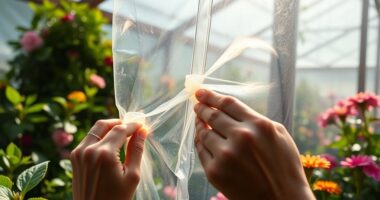To inspect and repair glazing panels, regularly check for cracks, chips, and deterioration that can weaken the glass or compromise weatherproofing. Guarantee seals and weatherproofing materials are intact, replacing any damaged parts promptly to prevent leaks and safety hazards. Proper installation and maintenance help extend the lifespan of your panels. Following safety standards during repairs protects everyone around you. Keep exploring to discover effective techniques for maintaining safety, durability, and energy efficiency.
Key Takeaways
- Regularly examine glazing panels for cracks, chips, or deterioration to ensure safety and prevent further damage.
- Check seals and weatherproofing around panels for signs of wear, moisture infiltration, or damage.
- Promptly replace broken or damaged glass panels following proper installation and safety standards.
- Maintain weatherproofing with sealants and protective films to enhance durability and energy efficiency.
- Follow manufacturer guidelines and safety protocols during inspections and repairs to ensure long-lasting, safe glazing.

Inspecting and repairing glazing panels is crucial to guarantee the safety and integrity of windows and glass installations. When you regularly check your glazing, you ensure that the glass remains safe for everyone around it. Glass safety is a top priority because damaged or compromised panels can pose serious risks, from falling glass shards to compromised security. By keeping an eye on the condition of your glazing, you prevent accidents and maintain the structural soundness of your building.
During inspections, focus on identifying cracks, chips, or any signs of deterioration. Small cracks can quickly escalate, especially under pressure from weather conditions or physical impacts. If you notice any damage, don’t delay repairs—addressing issues early can save you money and prevent further harm. When inspecting, also verify that seals and weatherproofing techniques are intact. Proper weatherproofing isn’t just about keeping the elements out; it also plays a crucial role in maintaining the longevity of your glazing panels. Damaged seals allow moisture and air infiltration, which can weaken the glass and frame over time, leading to higher energy costs and potential water damage. Additionally, understanding the shelf life of materials used in glazing can help determine when replacement might be necessary.
Inspect for cracks and damage to maintain glazing longevity and prevent costly issues.
Repairing glazing panels involves more than just replacing broken glass. You need to ensure that the new panels are properly installed, with secure fastenings and correct sealing. This process helps maintain the weatherproofing techniques you’ve implemented, which safeguard against drafts, leaks, and temperature fluctuations. When selecting replacement glass, consider the type of glazing suited for your climate and building requirements. Double-glazed or insulated glass units often provide better weatherproofing and energy efficiency, but they must be installed correctly to maximize their benefits.
In addition to repairs, you should routinely test weatherproofing measures. Check the seals around the glass for signs of wear, such as cracking or peeling. Applying weatherproofing techniques effectively can extend the lifespan of your glazing and improve energy efficiency. Techniques like applying sealant, using weatherstripping, or installing protective films can make a significant difference. When repairing or replacing glazing panels, always follow manufacturer guidelines and safety standards to ensure your work withstands environmental stressors and remains secure over time.
Frequently Asked Questions
What Safety Equipment Is Needed for Glazing Panel Inspection?
When inspecting glazing panels, you need to wear personal protective equipment like gloves, safety glasses, and a hard hat to stay safe. Make sure to use proper inspection tools such as a flashlight, utility knife, and level to thoroughly check the panels. Always prioritize safety by inspecting in a secure environment and handling tools carefully, so you can identify any damage or issues without risking injury.
How Often Should Glazing Panels Be Inspected for Damage?
Did you know that nearly 60% of glazing panel failures are due to undetected damage? You should inspect your glazing panels at least twice a year, following your maintenance schedule. Regular inspections help you spot damage indicators early, preventing costly repairs and safety hazards. Keep a close eye on cracks, chips, or seal failures, and perform more frequent checks if your panels are exposed to harsh weather or heavy traffic.
Can Glazing Panels Be Repaired On-Site or Do They Require Removal?
You can often perform on-site repairs for glazing panels, especially if the damage is minor. Small cracks or chips may only need glass replacement, which can be done without removing the entire panel. However, extensive damage or compromised structural integrity might require panel removal for proper glass replacement. Always assess the damage first, and if unsure, consult a professional for safe on-site repairs or glass replacement options.
What Are the Signs of Long-Term Glazing Panel Deterioration?
You might think glazing panels last forever, but long-term deterioration signs include glass discoloration that darkens or stains over time, and frame corrosion where rust weakens the structure. Don’t ignore these indicators; they compromise safety and energy efficiency. Regular inspection helps catch issues early, so you can repair or replace panels before costly damage occurs. Addressing these signs promptly keeps your building safe, functional, and visually appealing.
Are There Eco-Friendly Options for Glazing Panel Repairs?
Yes, you can opt for eco-friendly glazing panel repairs by using recycled materials and low-impact adhesives. These options reduce environmental impact while maintaining durability. Recycled glass or framing materials help minimize waste, and low-impact adhesives lower VOC emissions, making your repairs more sustainable. By choosing these eco-friendly solutions, you contribute to environmental conservation without sacrificing quality or safety in your glazing repairs.
Conclusion
By paying close attention to your glazing panels and addressing minor issues early, you help keep your space looking its best. Regular inspections act like gentle reminders, ensuring everything stays secure and beautiful. When small imperfections arise, a simple repair can prevent more significant concerns down the line. Think of it as giving your panels a little tender care—preserving their charm and function for years to come, all while maintaining a safe, inviting environment.









